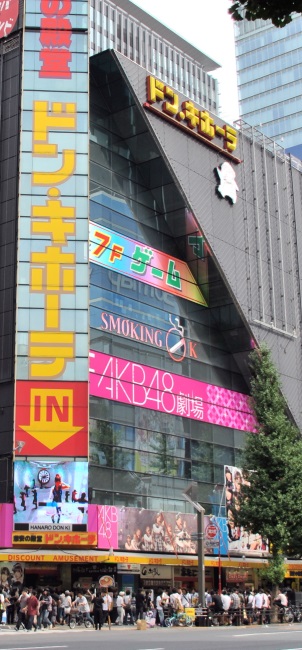
 |
| Katakana ドン・キホーテ |
|---|
| photo credit: Kuha455405 / CC licence |
The chōon (長音) (literally "long sound") mark or chōonpu (長音符) is a special symbol used with katakana to indicate a long vowel sound. For example the English word "free" is represented using the following three symbols: フリー, "fu", "ri", and the chōon mark, indicating that the vowel sound in ri is to be doubled in length. (See What is katakana used for? for a discussion of katakana.)
When writing horizontally, it is written as a horizontal bar, but when writing vertically, it is written as a vertical bar. In the picture, ドン・キホーテ, the name of a shop, "Don Quixote", is written both vertically on the left, and horizontally at the top right. Notice the change in the direction of the bar between the ho (ホ) and te (テ) kanas. See also Can Japanese be written right to left? for more on writing direction in Japanese.
Although it seems similar to the kanji character for the number "one", 一, the chōon can easily be distinguished by context. A chōon always appears after another katakana, but a one rarely does so. See How can I distinguish similar kana? for other pairs of easily-confused letters.
The chōon is sometimes used with hiragana in cases such as らーめん for "ramen", a kind of noodle dish, but usually hiragana indicates long vowels using hiragana rather than this mark.
The vertical and horizontal versions of the chōon mark are not
distinguished in Unicode. Both are represented as U+30FC, but
there is a halfwidth katakana version as U+FF70. See
What is half-width katakana? for more on halfwidth katakana.
Copyright © 1994-2025 Ben Bullock
If you have questions, corrections, or comments, please contact Ben Bullock or use the discussion forum / Privacy policy

|

|

|

|

|
| Book reviews |
Convert Japanese numbers |
Handwritten kanji recognition |
Stroke order diagrams |
Convert Japanese units |